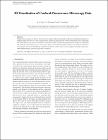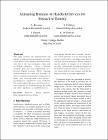Browsing Computer Science (Scholarly Publications) by Sponsor "Higher Education Authority"
Now showing items 1-20 of 25
-
3D visualisation of confocal flourescence microscopy data
(2004)Confocal microscopes are able to non-invasively capture sub-micron details of fluorescent-labelled specimens at multiple depths, but there is a lack of applications capable of displaying this collected information in a ... -
Adaptive medial-axis approximation for sphere-tree construction
(2004)Hierarchical object representations play an important role in performing efficient collision handling. Many different geometric primitives have been used to construct these representations, which allow areas of interaction ... -
Animating humans on handlheld devices for interactive gaming
(2005)This paper examines the implementation and efficacy of impostor-based techniques on smallscreen devices, and compares their effectiveness with that of the same techniques when used on desktop computers. Firstly, a ... -
An Automatically Composable OWL Reasoner for Resource Constrained Devices
(IEEE, 2009)Centralized semantic sensor network systems gradually show performance degradation as the scale of the sensor network increases. Thus systems based on distributed approaches with local, autonomous management features ... -
A context information service using ontology-based queries
(2004)Ubiquitous computing environments have the potential to provide rich sources of information about a user and their surroundings. However, the nature of context information means that it must be gathered in an ad-hoc ... -
Crowd and group simulation with levels of detail for geometry, motion and conversational behaviour
(2002)Work on levels of detail for human simulation has occurred mainly on a geometrical level, either by reducing the numbers of polygons representing a virtual human, or replacing them with a two-dimensional imposter. ... -
Evaluating the visual fidelity of physically based animations
(2003)For many systems that produce physically based animations, plausibility rather than accuracy is acceptable. We consider the problem of evaluating the visual quality of animations in which physical parameters have been ... -
An event model for real-time systems in mobile environments
(IEEE Computer Society, 2004)This paper describes an event model that has been designed to address the predictability requirements of applications operating in mobile environments based on hierarchically structured WAN-of-CANs networks. The event ... -
Exploiting proximity in event-based middleware for collaborative mobile applications
(Springer Berlin / Heidelberg, 2003)Middleware supporting event-based communication is widely recognized as being well suited to mobile applications since it naturally accommodates a dynamically changing population of interacting entities and the dynamic ... -
Fidelity metrics for animation
(2004)In this paper, the problem of evaluating the fidelity of animations will be addressed. Plausible simulation and the perceptual impact of animations generated using approximations or interactive manipulation will be ... -
From Subjects to Concept Clouds - Why semantic mapping is necessary
(2008)To realize the vision of the semantic web it is essential to be able to exchange formal modeled knowledge between applications and humans without loss of meaning. In this paper, we focus on questions relating to meaning, ... -
Geometry reduction for urban simulation on handheld devices
(2005)We present a real-time urban simulation on a Personal Digital Assistant (PDA). An existing desktop urban simulation is used to automatically generate potential visibility data, sub-divide the world into areas of similar ... -
Intuitive Human Governance of Autonomic Pervasive Computing Environments
(IEEE, 2005)This paper proposes an intuitive configuration tool for autonomic pervasive computing systems. Specifically the paper presents a system for the inference of user task intentions from a variety of sensed information and ... -
Levels of detail for crowds and groups
(Blackwell, 2002)Work on levels of detail for human simulation has occurred mainly on a geometrical level, either by reducing the numbers of polygons representing a virtual human, or replacing them with a two-dimensional imposter. ... -
LibViz: Data Visualisation of the Old Library
(2009)The Old Library of Trinity College Dublin, built in 1732, is an internationally renowned research library. In recent decades it has also become a major tourist attraction in Dublin, with the display of the Book of Kells ... -
On the role of ontological semantics in routing contextual knowledge in highly distributed autonomic systems
(Trinity College Dublin, 2006)Much recent research has focused on applying Autonomic Computing principles to achieve constrained self-management in adaptive systems, through self-monitoring and analysis, strategy planning, and self adjustment. ... -
Ontology-based engineering for self-managing communications
(multicon verlag, 2006)Ontology-based semantics support encoding and mapping between separately authored and thus heterogeneous knowledge, and is expressed in widely accepted standards (e.g. W3C?s OWL). It has been suggested that ontology-based ... -
Ontology-based semantics for composable autonomic elements
(2005)The complexity of modern communication networks requires an autonomic approach, where elements exhibit a degree of self-management which when combined provide a level of self-management for the network as a whole. The ... -
Policy Based Management for Internet Communities
(IEEE Press, 2004)Policy Based Management (PBM) is a research topic that has been driven by the tremendous complexity inherent in the administration and management of present-day networking and telecommunications systems and services. ... -
Policy-based management for resource-specific semantic service
(IEEE, 2006)Semantic Web Services are the subject of intense scrutiny as they promise to address problems of dynamically discovering, selecting, composing and interoperating web services for e-commerce. However, there has been ...























